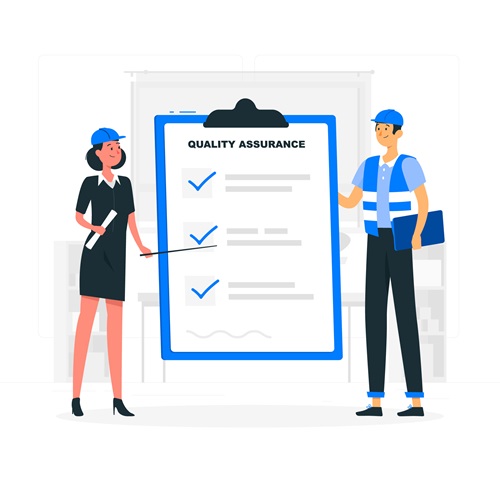7 Step Guide to Optimize Textile Production Process Through ERP
Optimizing the textile production process through ERP can be challenging but highly rewarding. Implementing the right ERP system can streamline operations, enhance productivity, and ensure quality control. However, many businesses struggle to maximize the benefits of their ERP due to improper implementation or underutilization.
ERP software enables you to manage and improve textile production efficiency, including inventory management, production planning, supply chain management, sales and order management, financial management, human resources, and quality management.
So, how can you optimize textile production process using ERP? This guide will walk you through a 7-step process, helping you ensure textile production best practices and harnessing your ERP’s full potential.
7 Steps to Optimize Textile Production Process Through ERP
Textile production processes can be optimized to increase efficiency and lower costs. Implementing an ERP software offers an organized strategy to achieve these objectives. Here, we highlight seven essential steps to optimize textile production process with ERP software for ensuring better resource management, increased productivity, and streamlined operations.
1. Assess Current Processes and Identify Gaps
Before implementing an ERP software to a textile business, identify the areas or gaps that are causing problems in the production process. Analyze each step from raw material procurement to final product delivery. Identify inefficiencies, bottlenecks, and areas where data is not being effectively utilized.
Key Actions:
- Conduct a thorough process audit.
- Gather input from various departments (production, inventory, sales, etc.).
- Identify pain points and areas needing improvement.

2. Define Clear Objectives

Set clear objectives for what the ERP software is expected to achieve. The goals can be like reducing lead times, minimizing textile waste, improving inventory management, or enhancing communication across departments.
Key Actions:
- Align objectives with overall business goals.
- Prioritize objectives based on impact and feasibility.
- Set measurable targets to track progress.
Having well-defined goals will guide the customization and implementation of the ERP software and clear objectives ensure that the ERP implementation stays focused and delivers tangible benefits.
3. Automate Workflow Processes
Use the ERP software to automate repetitive and time-consuming tasks to improve textile production efficiency. This can include tasks such as order processing, inventory management, production scheduling, and supply chain coordination.
Key Actions:
- Identify manual processes that are time consuming or prone to a lot of errors.
- Check if those processes can be automated.
- Configure your ERP to handle these tasks automatically.
ERP automation of workflow processes reduce manual workload, increase speed, and minimize errors. This leads to faster turnaround times and allows textile manufacturers to focus on more strategic tasks.

4. Optimize Inventory Management

Effective inventory management is crucial to optimize textile production process. Utilizing ERP inventory management helps streamline inventory processes, ensuring materials are available when needed and reducing holding costs.
Key Actions:
- Set up automated inventory tracking through ERP software to track stock levels in real-time.
- Configure automatic alerts for low stock levels to ensure timely reordering of materials.
- Analyze inventory data to identify slow-moving items and adjust purchasing strategies accordingly.
- Forecast demand based on historical data and market trend.
Optimizing inventory management through ERP software ensures that the right materials are available when needed, reducing production delays and holding costs. This leads to improved inventory turnover rates, lower waste, and enhanced overall efficiency in the textile production process.
5. Implement Real-Time Monitoring and Reporting
An ERP allows you to implement real-time monitoring and reporting for gaining essential insights into production performance. You get access to several crucial reports that your ERP generates based on your business data. These reports help you track key performance indicators (KPIs) and make informed decisions based on real-time data.
Key Actions:
- Create personalized dashboards tailored to different roles within your organization.
- Define key performance indicators (KPIs) and track critical metrics
- Configure real-time alerts to notify staff of any anomalies or deviations from expected performance
- Implement graphs, charts, and other visualization tools to make data easily understandable and quickly identify trends.

Implementing real-time monitoring and reporting provides immediate access to critical data for proactive management and timely decision-making. Real-time insights will allow your team to respond quickly to issues, reduce downtime and optimize textile production process.
6. Integrate Quality Control Mechanisms

Integrating robust quality control measures within your ERP system is crucial for maintaining high product standards and optimizing the textile production process. By embedding quality control into your ERP, you can ensure that raw materials meet the required standards and maintain consistent product quality throughout every stage of production.
Key Actions:
- Incorporate quality checks at critical points in the production process to catch issues early and prevent defects from progressing.
- Automate quality control alerts to notify relevant personnel of quality issues in real time. This enables immediate corrective actions.
- Ensure that quality standards and inspection criteria are regularly reviewed and updated in the ERP software to ensure compliance with industry regulations and evolving customer expectations.
- Use ERP software to record quality control data and generate reports for continuous improvement and audit readiness.
By integrating quality control mechanisms within your ERP software, you can ensure consistent product quality, reduce defects, and enhance customer satisfaction. This also strengthens your compliance with industry standards and boosts your reputation for reliability and excellence.
7. Foster Collaboration and Communication
Fostering collaboration and communication across departments is vital to optimize the textile production process. The ERP software can significantly improve these aspects by providing a centralized platform for information sharing and workflow management.
Key Actions:
- Implement real-time communication tools within the ERP software, such as instant messaging and notifications.
- Schedule regular meetings and updates through the ERP software to ensure all team members are aligned with project goals and timelines.
- Enable document sharing and collaboration by using the ERP software as a repository for critical documents and data.

Establishing communication between departments through an ERP software leads to improved teamwork and coordination, resulting in optimized textile production processes. It ensures that all departments are on the same page, reducing misunderstandings and production delays. This ultimately enhances operational efficiency and drives continuous improvement in the textile production process.
Implementing an ERP software is one of the best ways to optimize the textile production process. By following this 7-step guide, textile manufacturers can improve textile production efficiency, streamline workflows, improve inventory management, and enhance quality control. Real-time monitoring, automation, and improved collaboration lead to increased efficiency, reduced costs, and higher product quality. An ERP software ensures textile production best practices are implemented. This helps business owners to ensure smoother operations and a stronger, more responsive business eventually leading to an optimized textile production process.

